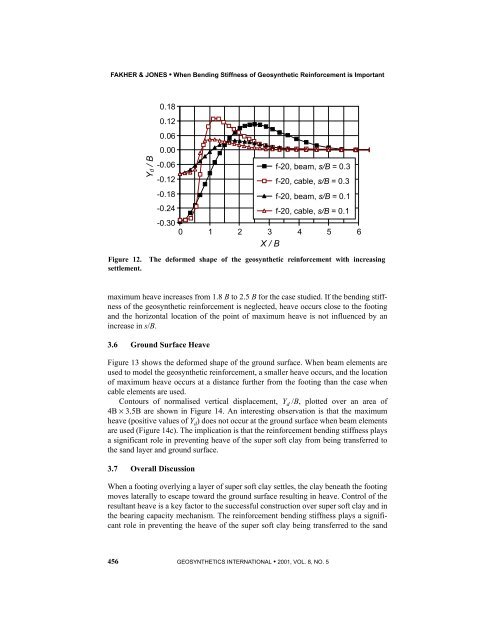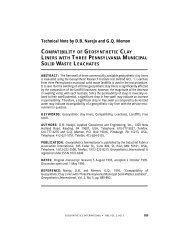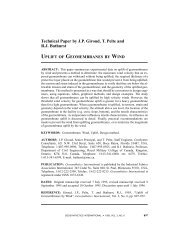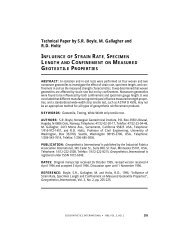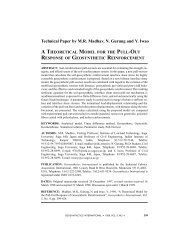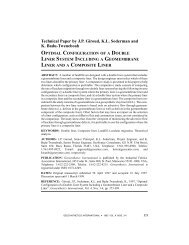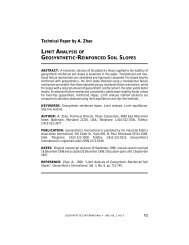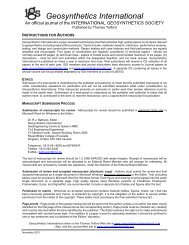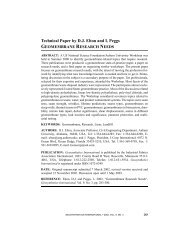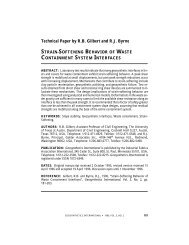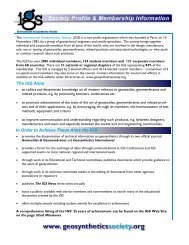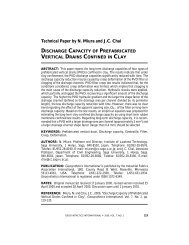Technical Paper by A. Fakher and C.J.F.P. Jones WHEN THE ...
Technical Paper by A. Fakher and C.J.F.P. Jones WHEN THE ...
Technical Paper by A. Fakher and C.J.F.P. Jones WHEN THE ...
Create successful ePaper yourself
Turn your PDF publications into a flip-book with our unique Google optimized e-Paper software.
FAKHER & JONES • When Bending Stiffness of Geosynthetic Reinforcement is Important<br />
Yd / B<br />
0.18<br />
0.12<br />
0.06<br />
0.00<br />
-0.06<br />
-0.12<br />
-0.18<br />
-0.24<br />
-0.30<br />
f-20, beam, s/B = 0.3<br />
f-20, cable, s/B = 0.3<br />
f-20, beam, s/B = 0.1<br />
f-20, cable, s/B = 0.1<br />
0 1 2 3 4 5 6<br />
X / B<br />
Figure 12.<br />
settlement.<br />
The deformed shape of the geosynthetic reinforcement with increasing<br />
maximum heave increases from 1.8 B to 2.5 B for the case studied. If the bending stiffness<br />
of the geosynthetic reinforcement is neglected, heave occurs close to the footing<br />
<strong>and</strong> the horizontal location of the point of maximum heave is not influenced <strong>by</strong> an<br />
increase in s/B.<br />
3.6 Ground Surface Heave<br />
Figure 13 shows the deformed shape of the ground surface. When beam elements are<br />
used to model the geosynthetic reinforcement, a smaller heave occurs, <strong>and</strong> the location<br />
of maximum heave occurs at a distance further from the footing than the case when<br />
cable elements are used.<br />
Contours of normalised vertical displacement, Y d /B, plotted over an area of<br />
4B × 3.5B are shown in Figure 14. An interesting observation is that the maximum<br />
heave (positive values of Y d ) does not occur at the ground surface when beam elements<br />
are used (Figure 14c). The implication is that the reinforcement bending stiffness plays<br />
a significant role in preventing heave of the super soft clay from being transferred to<br />
the s<strong>and</strong> layer <strong>and</strong> ground surface.<br />
3.7 Overall Discussion<br />
When a footing overlying a layer of super soft clay settles, the clay beneath the footing<br />
moves laterally to escape toward the ground surface resulting in heave. Control of the<br />
resultant heave is a key factor to the successful construction over super soft clay <strong>and</strong> in<br />
the bearing capacity mechanism. The reinforcement bending stiffness plays a significant<br />
role in preventing the heave of the super soft clay being transferred to the s<strong>and</strong><br />
456 GEOSYN<strong>THE</strong>TICS INTERNATIONAL • 2001, VOL. 8, NO. 5


